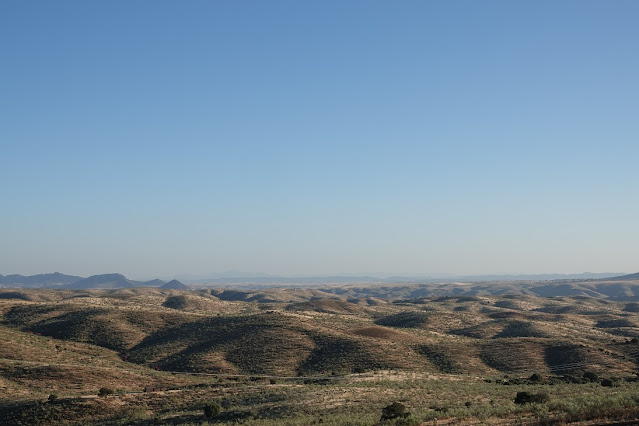A land of extremes
 |
| La Serena (Martin Kelsey) |
There is a popular misconception that the name of our region, Extremadura, is derived from the union of two Spanish words which translate as "extremely hard". It is a belief that reinforces another misconception: that the region is tough and inhospitable. An area that people have sought to escape from rather than to arrive in. Sure, on the vast plains in central and southern Extremadura, spring peters out early by mid-May. Thistles have seeded and grasses have hauntingly become dust-yellow and brittle. By then, these landscapes have indeed become extremely hard. The view north from the village of Peñalsorda in the deep south-east of Extremadura offers a panorama with undulations recalling desert dunes, with the remote castle of Puebla de Alcocer, marking a northern limit. Over much of the plains of La Serena the soil is so thin that slaty dog's teeth of crooked, jagged rock break the surface.
 |
| Dog's Teeth (Martin Kelsey) |
Hidden from that view, spidering through the topography to mark historic watercourses, lies the vast La Serena reservoir. Covering 14,000 hectares, today it is barely at 25% of its capacity. A testament to a decade of rainfall deficit. Bleached hillsides, bare of any live vegetation, or indeed soil, are evidence of where water used to be, reaching a line of geometric horizontal precision, the high water mark. Above that boundary parched herbaceous cover, tufty silvery grey Retama bushes and the occasional holm oak grow. The average capacity over the last decade was 75%. This was significant for the task in hand, as I was looking for heronries, using data from the previous national census a decade earlier.
Carrying a government authorisation allowed me to travel outside the enclave of my own province (Cáceres) into the the southern half of Extremadura. COVID-19 lockdown was in a phased relaxation, with limits of movement still in place. Colonies of herons are often in zones of inundated dead trees. Now those trees stood on dry land, far from water. I had to go to the distant extreme of the reservoir where the River Esteras entered from Castille-La Mancha to find areas where the trees were still in, or beside, water. Parties of Red-billed Chough rippled over the sheep pasture whilst on silt beaches Little Terns were in courtship. A noisy chuntering endlessly flowed from the vast colony of Great Cormorants here, adults panting on their nests. Pock-marked through the skeletal structure of what would have been riverine gallery forest before the reservoir's dam was completed in 1990, were Grey Heron nests, finding protection at last.
 |
| Great Cormorant colony (Martin Kelsey) |
My fieldwork also took me along slow-flowing rivers downstream of dams, where the species I encountered most often was the lithe Purple Heron. Their nests were much harder to find, bunkered down in the depths of Typha or Phragmites beds. But the birds were easy to see, sometimes in flight with their long-necks packed into a coil-like bulge, sometimes stationary at the edge of still water, eyes focussed for fish fry, ready for the brain to send its lethal message to the monstrous dagger of a bill.
 |
| Purple Heron (Martin Kelsey) |
In a straight line north-north-west of 185 km, or 268 km by road, my sense of extremes became absolute. A week after my exploration in the summer brown of La Serena, I now stood in a mountain flower meadow. I had shifted back in time to early spring.
 |
| Mountain meadow in northern Extremadura (Martin Kelsey) |
Butterflies were my pursuit but I became easily distracted by Red-backed Shrikes, Common Whitethroats and Firecrests, birds of more northern breeding ranges, captured as it were by the Extremadura's reach into the Gredos Mountains. I looked up to the broom moorland above the trees and a small pocket of snow sat tucked in a gully. Soft rattles of Western Bonelli's Warbler song reached me from all angles. There were a good selection of fritillary butterflies to soak in too.
 |
| Niobe Fritillary (Martin Kelsey) |
Marsh, Niobe and Knapweed were abundant, but these are quite widespread species in northern Extremadura, but the Small Pearl-bordered Fritillaries were, like the Red-backed Shrikes, right at the southern limit of their range, at home in a landscape that welcomed.
 |
| Small Pearl-bordered Fritillary (Martin Kelsey) |



Comments
Brian Banks